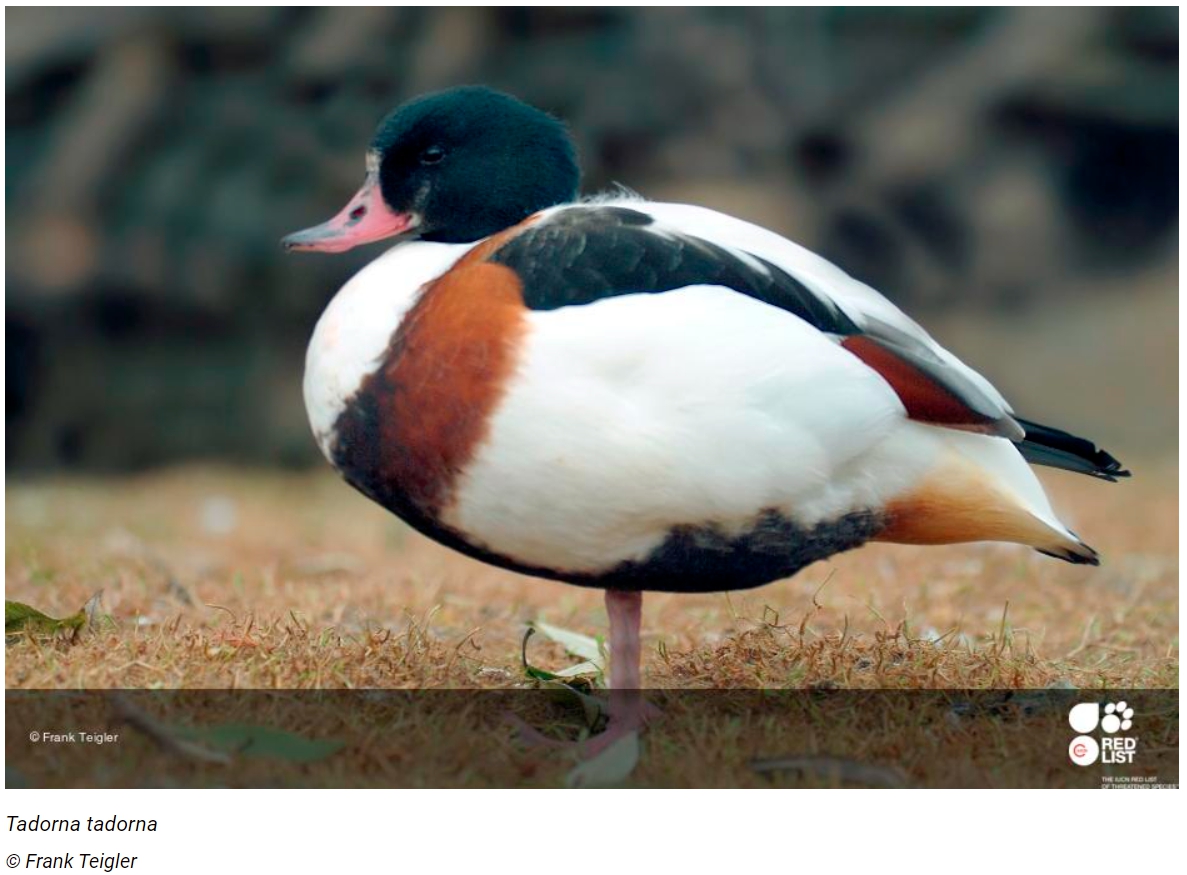| Citation |
BirdLife International. 2019. Tadorna tadorna. The IUCN Red List of Threatened Species 2019: e.T22680024A154560262. https://dx.doi.org/10.2305/IUCN.UK.2019-3.RLTS.T22680024A154560262.en. Accessed on 13 March 2022. Brinkman, J.J., van der Ven, W., Allen, D., Hutchinson, R., Jensen, A.E., Perez, C. (2021): Checklist of birds of the Philippines. Wild Bird Club of the Philippines. www.birdwatch.ph |
Description |
JUSTIFICATION
This species has an extremely large range, and hence does not approach the thresholds for Vulnerable under the range size criterion (Extent of Occurrence <20,000 km2 combined with a declining or fluctuating range size, habitat extent/quality, or population size and a small number of locations or severe fragmentation). The population trend appears to be increasing, and hence the species does not approach the thresholds for Vulnerable under the population trend criterion (>30% decline over ten years or three generations). The population size is very large, and hence does not approach the thresholds for Vulnerable under the population size criterion (<10,000 mature individuals with a continuing decline estimated to be >10% in ten years or three generations, or with a specified population structure). For these reasons the species is evaluated as Least Concern.
DESCRIPTION
The global population is estimated to number 625,000-750,000 individuals (Wetlands International 2015). This roughly equates to 415,000-500,000 mature individuals. The European population is estimated at 50,800-68,900 pairs, which equates to 102,000-138,000 mature individuals (BirdLife International 2015).
Trend Justification: The overall population trend is increasing, although several populations have unknown trends (Wetlands International 2015). In Europe, the population trend is estimated to be increasing (BirdLife International 2015).
HABITAT AND ECOLOGY
Behaviour Most populations of this species are migratory (although European populations are largely sedentary) and undertake extensive moult migrations to favoured moulting sites after breeding (Asiatic breeding populations may also moult near their breeding grounds) (del Hoyo et al. 1992, Kear 2005). The species breeds in single pairs or small groups, non-breeders usually remaining in flocks throughout the year (Flint et al. 1984, del Hoyo et al. 1992, Kear 2005). After breeding (between July and October) the species moults and becomes flightless for 25-31 days, during which it is highly gregarious and may aggregate into large flocks of up to 100,000 individuals or more (Madge and Burn 1988, del Hoyo et al. 1992, Kear 2005).
Habitat The species shows a preference for saline habitats and frequents mudflats and muddy or sandy estuaries in coastal regions, and occurs inland on saline and brackish lakes in steppe or semi-desert (Madge and Burn 1988, del Hoyo et al. 1992). Asiatic populations also occupy freshwater rivers or marshes and other populations utilise freshwater habitats on migration (Flint et al. 1984, Kear 2005).
Diet Its diet consists predominantly of salt-water molluscs (e.g. Hydrobia spp.) as well as other aquatic invertebrates (e.g. insects, crustaceans and worms), small fish, fish spawn and plant material (e.g. algae, seeds and agricultural grain) (del Hoyo et al. 1992, Kear 2005).
Breeding site The nest is commonly positioned in a tree-hollow up to 8 m above the ground or in a mammal burrow (e.g. of European rabbit Oryctolagus cuniculus) (del Hoyo et al. 1992, Kear 2005). Rarely nests may also be placed in the open or in dense vegetation up to 1 km from water (Madge and Burn 1988, Kear 2005). The species will also nest in artificial nest-boxes (Kear 2005).
Management information Studies in Danish coastal wetlands found that the spatial restriction of shore-based shooting was more successful at maintaining waterfowl population sizes than was the temporal restriction of shooting, and therefore that wildfowl reserves should incorporate shooting-free refuges that include adjacent marshland in order to ensure high waterfowl species diversity (Bregnballe et al. 2004). In the outer archipelago of south-west Finland experimental removal (extermination) of the nest predator American mink Neovison vison resulted in an increase in the breeding density of this species (Nordström et al. 2002).
THREATS
The species is threatened by habitat loss as a result of tidal barrage schemes in Europe (Kear 2005, Burton 2006). It also suffers predation from American mink Neovison vison on islands (Nordström et al. 2002) and is susceptible to avian influenza so may be threatened by future outbreaks of the virus (Melville and Shortridge 2006).
Utilisation The species is hunted for commercial and recreational purposes in Iran (Balmaki and Barati 2006), and its eggs used to be (and possibly still are) harvested in Iceland (Gudmundsson 1979).
CONSERVATION ACTIONS
Conservation Actions Underway
CMS Appendix II. Bern Convention Appendix II. There are currently no known conservation measures for this species in Europe.
Conservation Actions Proposed
The following information refers to the speciess European range only: Predator control at breeding sites would help this species locally and the construction of artificial caves may increase local breeding pair numbers (HELCOM 2013). Important areas for this species need to be protected. Environmental impact assessments for new tidal energy schemes should be undertaken. |

